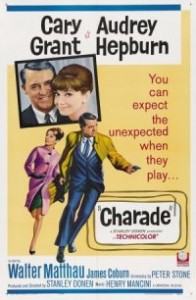 “You can expect the unexpected when they play….charade.”
“You can expect the unexpected when they play….charade.”
During his long career, Cary Grant seemed to get away with murder, though he was never a screen murderer (personally unverified), yet he came close in Alfred Hitchcock’s Suspicion but was denied that label by the censors. Rather, “by getting away with murder” I mean this old man played opposite all those glamorous ladies, being their lover on screen and, quite as often, off screen, and taking away all the laurels in both cases.
When in 1946 in Notorious he made passionate love to Ingrid Bergman on and off screen, there was only an eleven year different in their ages. So, okay, all right. Plausible. We’ll let this one pass.
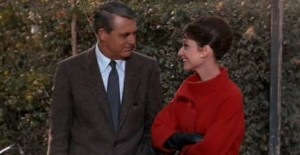 But what about the next salient picture when the age difference was upped considerably, enough to raise the eyebrows of little old ladies brought up in a more puritanical time which now seems beyond most people’s memories? What about twenty-five years? Eh? That’s the age difference when Grace Kelly joined Cary in a Riviera frolic in To Catch a Thief, courtesy once again of Hitchcock. And, my, my, were there fireworks here—both in the sky pyrotechnics and in the stars’ eyes, and the sexual innuendos in their dialogue. And off screen—well, Grace Kelly was a known nymphomaniac, so there was no hesitation on his part.
But what about the next salient picture when the age difference was upped considerably, enough to raise the eyebrows of little old ladies brought up in a more puritanical time which now seems beyond most people’s memories? What about twenty-five years? Eh? That’s the age difference when Grace Kelly joined Cary in a Riviera frolic in To Catch a Thief, courtesy once again of Hitchcock. And, my, my, were there fireworks here—both in the sky pyrotechnics and in the stars’ eyes, and the sexual innuendos in their dialogue. And off screen—well, Grace Kelly was a known nymphomaniac, so there was no hesitation on his part.
And what of another movie made a couple of years later, The Pride and the Passion? All right, a Cary Grant miscasting and generally a poor effort, as lumbering as that cannon the Spanish loyalists dragged across Spain, but the age differential had increased now to thirty years. Sophia Loren was twenty-three, Cary Grant Grant fifty-three. Hey, the threes are the same! No matter. It’s still thirty years. During filming, it didn’t seem to matter to either Sophia Loren or Cary Grant—this one of his hottest affairs—but for one reason or another, she didn’t wish to continue the liaison.
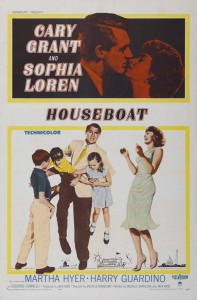 There were later reunions with both Ingrid Bergman in Indiscreet and Sophia Loren in Houseboat (their age differences remaining the same!) and roles opposite Deborah Kerr (again) and Eva Marie Saint, but a particularly career-defying film in which Cary Grant took advantage of yet another young lady was Delbert Mann’s smoothly directed That Touch of Mink. The result? Yep, the public was still buying, and liking, the ongoing Cary Grant image. And now the star was perky Doris Day, in the manner of Pillow Talk and Move Over, Darling. The age disparity was back down to “only” twenty years—the actress, again, the younger.
There were later reunions with both Ingrid Bergman in Indiscreet and Sophia Loren in Houseboat (their age differences remaining the same!) and roles opposite Deborah Kerr (again) and Eva Marie Saint, but a particularly career-defying film in which Cary Grant took advantage of yet another young lady was Delbert Mann’s smoothly directed That Touch of Mink. The result? Yep, the public was still buying, and liking, the ongoing Cary Grant image. And now the star was perky Doris Day, in the manner of Pillow Talk and Move Over, Darling. The age disparity was back down to “only” twenty years—the actress, again, the younger.
The final stop in this highlighted glance at Cary Grant’s continually advancing age vis-à-vis courting young women of a similar age inequality is Charade, made in 1963 and directed by Stanley Donen, the third to last of the actor’s films. It’s one of his best, clearly his best since North by Northwest in 1959 and, before that, Notorious in 1946. (It could be argued that, in certainly three of the Grant/Hitch films—I’ve never ranked Suspicion as totally successful, either as a Cary Grant or a Hitchcock film—the actor made the best movies of his career.)
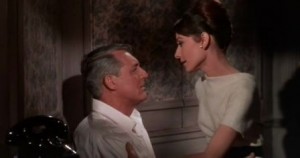 In Charade, Cary Grant is in and out of trouble, now suspiciously a predator, now a charming comforter, with Audrey Hepburn, twenty-five years his junior. The age discrepancy is openly confronted in this comedy-mystery. When Cary Grant shows concern for her, she responds, “Here it comes, the fatherly talk.” And in the same scene, with Audrey on his lap, he makes the obvious point by suggesting the opposite: “You’re too old for me. . . . Serious. When a man gets to be my age, that’s the last word he wants to hear.” Later, on a nocturnal river cruise, she rationalizes his gray hair and lined face: “You don’t look so bad in this light.” At film’s end, age is of no consequence, at least in the script.
In Charade, Cary Grant is in and out of trouble, now suspiciously a predator, now a charming comforter, with Audrey Hepburn, twenty-five years his junior. The age discrepancy is openly confronted in this comedy-mystery. When Cary Grant shows concern for her, she responds, “Here it comes, the fatherly talk.” And in the same scene, with Audrey on his lap, he makes the obvious point by suggesting the opposite: “You’re too old for me. . . . Serious. When a man gets to be my age, that’s the last word he wants to hear.” Later, on a nocturnal river cruise, she rationalizes his gray hair and lined face: “You don’t look so bad in this light.” At film’s end, age is of no consequence, at least in the script.
Charade has many Hitchcockian overtones. Even before Maurice Binder’s psychedelic main title graphics and Henry Mancini’s music, with the camera panning a landscape to double railroad tracks, we have one of Hitch’s most popular motifs, a train, specifically the Paris-to-Bordeaux express. From the speeding train plunges a man, clad only in his pajamas, all dead and wide-eyed. (I swear, beneath the makeup and cuts and bruises, it’s Cary Grant!)
The dead man is Regina Lampert’s (Hepburn) estranged husband, Charles. The police show her the contents of his Lufthansa travel satchel (this was, now, 1963, when airlines were generous with such extras) that include her apartment key, a toothbrush and tooth powder, a comb, a wallet containing 4,000 francs, an envelope with a letter from the husband, a fountain pen and an itinerary pad.
Peter Joshua (Cary Grant), whom she had met at an Alpine ski resort, appears at her empty Paris apartment, the contents of which had been sold by Charles. At the funeral, the so-called mourners include a bald-headed man (Ned Glass) who sneezes uncontrollably beside the open coffin, a Texan (James Coburn) who tells Regina “he shouldn’t’ve done it that way” and, most frightening of all, an enormous man in a raincoat (George Kennedy) who pricks the corpse with a straight pin.
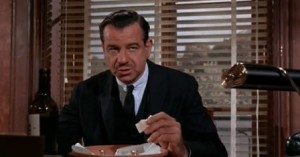 And, last at the funeral, a man delivers a note from Hamilton Bartholomew of the CIA; he asks Regina to drop by his office to discuss her husband’s death. Walter Matthau’s laid-back performance as Bartholomew will remind viewers of other such roles—pretty much the typical Matthau persona—detective Caselle in Mirage, Dr. Nichols in House Calls, Captain Red in Pirates and, of course, Oscar Madison in The Odd Couple.
And, last at the funeral, a man delivers a note from Hamilton Bartholomew of the CIA; he asks Regina to drop by his office to discuss her husband’s death. Walter Matthau’s laid-back performance as Bartholomew will remind viewers of other such roles—pretty much the typical Matthau persona—detective Caselle in Mirage, Dr. Nichols in House Calls, Captain Red in Pirates and, of course, Oscar Madison in The Odd Couple.
Later, at a restaurant, Bartholomew tells Regina that the three men at the funeral, along with Charles, were on a World War II mission to deliver $250,000 in gold to the French Underground, ingots that, instead, they buried and accused the Germans of stealing. The three men believe that Charles had gotten to the fortune before them and they want their share.
With this the stage is set. All kinds of intrigues, suspicious identities, pursuits and threats follow, reinforcing the mystery of course, but providing ample helpings of humor and romance. Probably Matthau has the longest stretches of dialogue, while Cary Grant and Audrey Hepburn and the three thugs exchange quick and quirky one-liners. The script, by Peter Stone and Marc Behm, is something of a masterpiece.
A delectable ingredient in the film is the Paris scenery, although often, as in the chase through a couple of Métro stations and down the rue Montpensier, some of the sights are only glimpsed. There are also the Théâtre de Guignol with its famous puppet shows, the Hôtel Saint-Jacques and the EURESCO where Regina works as a translator. Most of the interior scenes were filmed at Universal City, California, and at Studios de Boulogne-Billancourt in Paris.